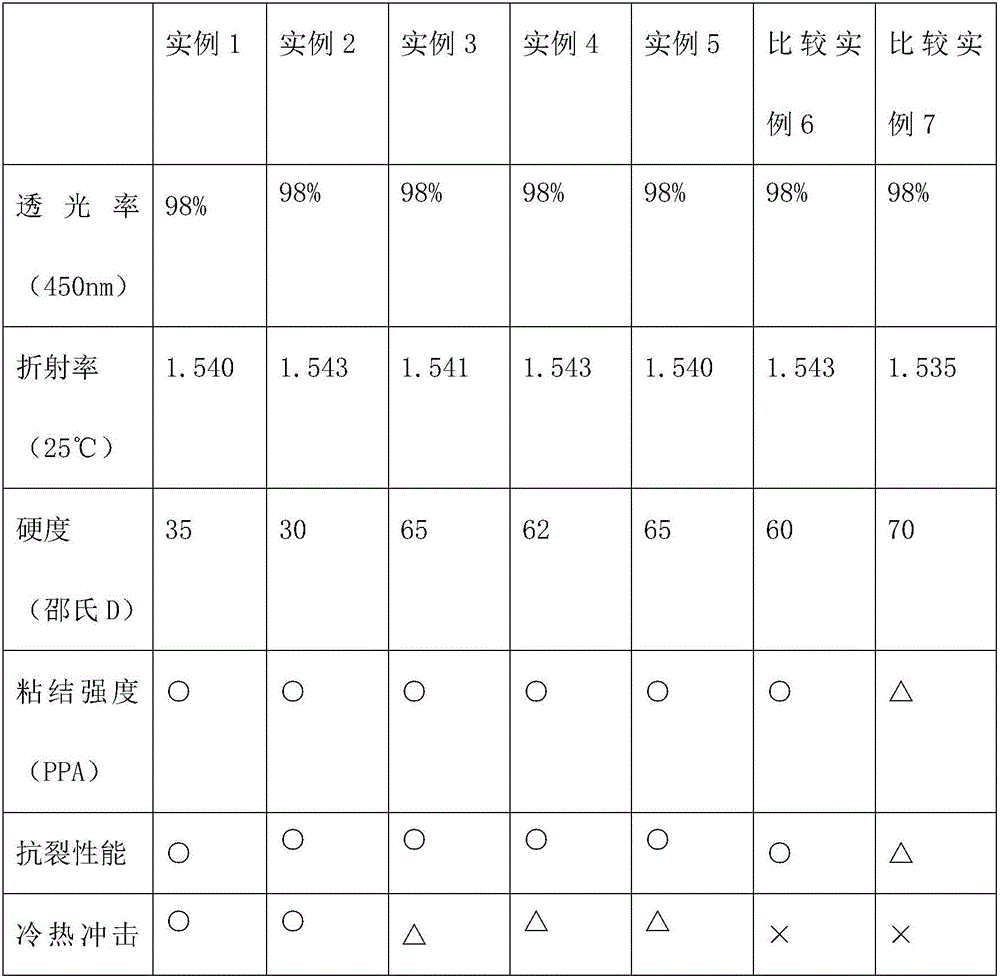Synthesis method of silicone resin with core-shell structure for LED packaging
A technology of LED packaging and core-shell structure, which is applied in the field of synthesis of silicone resin, can solve the problems of poor resistance to cold and heat shocks, and achieve the effects of improving toughness, good reproducibility and controllability, and facilitating large-scale production
- Summary
- Abstract
- Description
- Claims
- Application Information
AI Technical Summary
Problems solved by technology
Method used
Image
Examples
Embodiment 1
[0019] First, weigh 41.6g (0.2mol) tetraethoxysilane and 60g ethanol in sequence, mix them evenly, and pour them into a 500ml four-neck flask with cooling, stirring and heating devices; then, slowly drop them at 25°C Add 49.5g of hydrochloric acid aqueous solution with PH=1, and continue to react for 1h after the dropwise addition; 18g (0.15mol) of dimethyldimethoxysilane monomer mixture, after the dropwise addition, the temperature was raised to 60°C for 6 hours; then 18.6g (0.1mol) of divinyltetramethyldisiloxane was added to the system to continue React for 10 hours; finally, add about 100g of toluene and let it stand, separate layers, wash until neutral, and distill under reduced pressure to obtain 137.5g of colorless and transparent silicone resin with a refractive index of 1.535, a viscosity of 36850mPaS, and a vinyl content of 3.7%. The rate is 94.0%.
Embodiment 2
[0021] First, weigh 20.8g (0.1mol) tetraethoxysilane and 60g ethanol in sequence, mix them evenly, and pour them into a 500ml four-neck flask equipped with cooling, stirring and heating devices; then, slowly drop them at 25°C Add 47.7g of hydrochloric acid aqueous solution with PH=1, and continue to react for 1h after the dropwise addition; 19.8g (0.15mol) of methylvinyldioxysilane monomer mixture, after the dropwise addition, the temperature was raised to 60°C for 6 hours; then 16.2g (0.1mol) of hexamethyldisiloxane was added to the system to continue the reaction for 10 hours ; Finally, add about 100g toluene and let stand, separate layers, wash to neutrality, and distill under reduced pressure to obtain 140.3g colorless and transparent silicone resin, the refractive index is 1.547, the viscosity is 29370mPaS, the vinyl content is 2.6%, and the yield is 91.9%.
Embodiment 3
[0023] First, weigh 20.8g (0.1mol) tetraethoxysilane and 60g ethanol in sequence, mix them evenly, and pour them into a 500ml four-neck flask equipped with cooling, stirring and heating devices; then, slowly drop them at 25°C Add 44.1g of hydrochloric acid aqueous solution with PH=1, and continue to react for 1h after the dropwise addition; 19.8g (0.15mol) of methylvinyldioxysilane monomer mixture, after the dropwise addition, the temperature was raised to 60°C for 6 hours; then 18.6g (0.1mol) of divinyltetramethyldisiloxane was added to the system Continue the reaction for 10 hours; finally, add about 100g of toluene and let it stand, separate layers, wash until neutral, and distill under reduced pressure to obtain 132.6g of colorless and transparent silicone resin with a refractive index of 1.537, a viscosity of 21690mPaS, and a vinyl content of 6.6%. The yield was 93.3%.
PUM
| Property | Measurement | Unit |
|---|---|---|
| refractive index | aaaaa | aaaaa |
| refractive index | aaaaa | aaaaa |
| refractive index | aaaaa | aaaaa |
Abstract
Description
Claims
Application Information
 Login to View More
Login to View More - R&D
- Intellectual Property
- Life Sciences
- Materials
- Tech Scout
- Unparalleled Data Quality
- Higher Quality Content
- 60% Fewer Hallucinations
Browse by: Latest US Patents, China's latest patents, Technical Efficacy Thesaurus, Application Domain, Technology Topic, Popular Technical Reports.
© 2025 PatSnap. All rights reserved.Legal|Privacy policy|Modern Slavery Act Transparency Statement|Sitemap|About US| Contact US: help@patsnap.com


